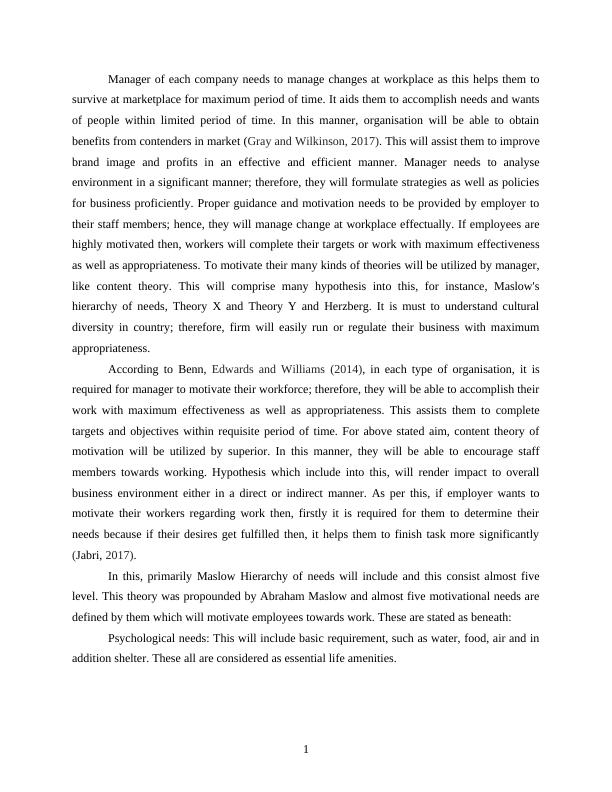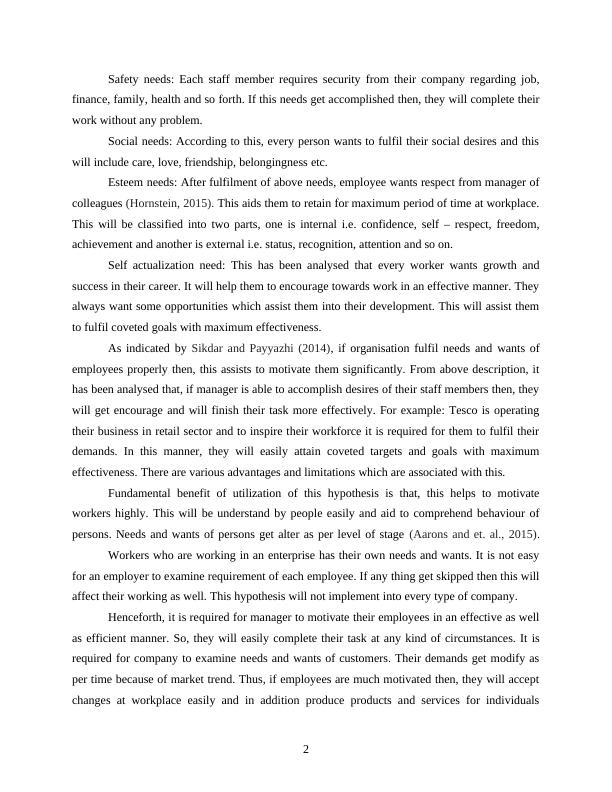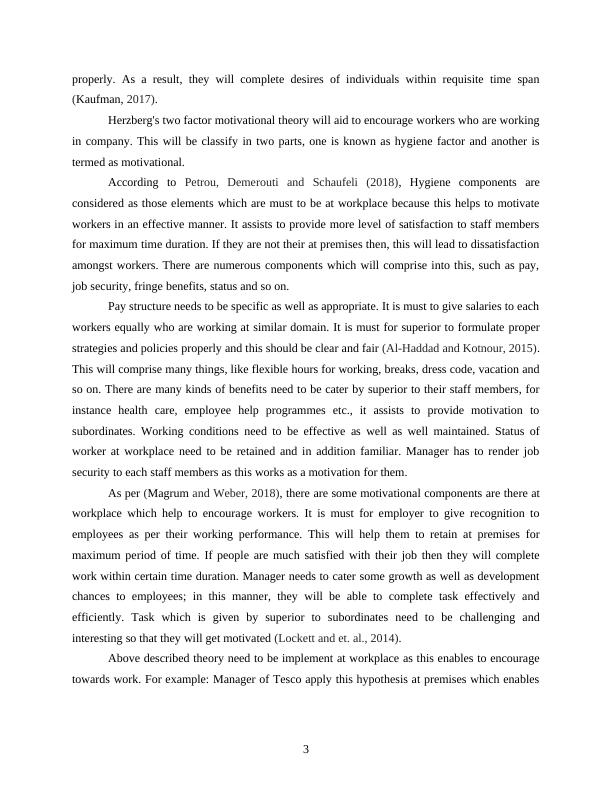Ask a question from expert
Managing Organisational Change Essay
11 Pages4542 Words57 Views
Added on 2020-07-22
Managing Organisational Change Essay
Added on 2020-07-22
BookmarkShareRelated Documents
Managing OrganisationalChange

Manager of each company needs to manage changes at workplace as this helps them tosurvive at marketplace for maximum period of time. It aids them to accomplish needs and wantsof people within limited period of time. In this manner, organisation will be able to obtainbenefits from contenders in market (Gray and Wilkinson, 2017). This will assist them to improvebrand image and profits in an effective and efficient manner. Manager needs to analyseenvironment in a significant manner; therefore, they will formulate strategies as well as policiesfor business proficiently. Proper guidance and motivation needs to be provided by employer totheir staff members; hence, they will manage change at workplace effectually. If employees arehighly motivated then, workers will complete their targets or work with maximum effectivenessas well as appropriateness. To motivate their many kinds of theories will be utilized by manager,like content theory. This will comprise many hypothesis into this, for instance, Maslow'shierarchy of needs, Theory X and Theory Y and Herzberg. It is must to understand culturaldiversity in country; therefore, firm will easily run or regulate their business with maximumappropriateness.According toBenn, Edwards and Williams (2014), in each type of organisation, it isrequired for manager to motivate their workforce; therefore, they will be able to accomplish theirwork with maximum effectiveness as well as appropriateness. This assists them to completetargets and objectives within requisite period of time. For above stated aim, content theory ofmotivation will be utilized by superior. In this manner, they will be able to encourage staffmembers towards working. Hypothesis which include into this, will render impact to overallbusiness environment either in a direct or indirect manner. As per this, if employer wants tomotivate their workers regarding work then, firstly it is required for them to determine theirneeds because if their desires get fulfilled then, it helps them to finish task more significantly(Jabri, 2017). In this, primarily Maslow Hierarchy of needs will include and this consist almost fivelevel. This theory was propounded by Abraham Maslow and almost five motivational needs aredefined by them which will motivate employees towards work. These are stated as beneath:Psychological needs: This will include basic requirement, such as water, food, air and inaddition shelter. These all are considered as essential life amenities.1

Safety needs: Each staff member requires security from their company regarding job,finance, family, health and so forth. If this needs get accomplished then, they will complete theirwork without any problem.Social needs: According to this, every person wants to fulfil their social desires and thiswill include care, love, friendship, belongingness etc.Esteem needs: After fulfilment of above needs, employee wants respect from manager ofcolleagues (Hornstein, 2015). This aids them to retain for maximum period of time at workplace.This will be classified into two parts, one is internal i.e. confidence, self – respect, freedom,achievement and another is external i.e. status, recognition, attention and so on.Self actualization need: This has been analysed that every worker wants growth andsuccess in their career. It will help them to encourage towards work in an effective manner. Theyalways want some opportunities which assist them into their development. This will assist themto fulfil coveted goals with maximum effectiveness.As indicated by Sikdar and Payyazhi (2014), if organisation fulfil needs and wants ofemployees properly then, this assists to motivate them significantly. From above description, ithas been analysed that, if manager is able to accomplish desires of their staff members then, theywill get encourage and will finish their task more effectively. For example: Tesco is operatingtheir business in retail sector and to inspire their workforce it is required for them to fulfil theirdemands. In this manner, they will easily attain coveted targets and goals with maximumeffectiveness. There are various advantages and limitations which are associated with this. Fundamental benefit of utilization of this hypothesis is that, this helps to motivateworkers highly. This will be understand by people easily and aid to comprehend behaviour ofpersons. Needs and wants of persons get alter as per level of stage (Aarons and et. al., 2015).Workers who are working in an enterprise has their own needs and wants. It is not easyfor an employer to examine requirement of each employee. If any thing get skipped then this willaffect their working as well. This hypothesis will not implement into every type of company. Henceforth, it is required for manager to motivate their employees in an effective as wellas efficient manner. So, they will easily complete their task at any kind of circumstances. It isrequired for company to examine needs and wants of customers. Their demands get modify asper time because of market trend. Thus, if employees are much motivated then, they will acceptchanges at workplace easily and in addition produce products and services for individuals2

properly. As a result, they will complete desires of individuals within requisite time span(Kaufman, 2017). Herzberg's two factor motivational theory will aid to encourage workers who are workingin company. This will be classify in two parts, one is known as hygiene factor and another istermed as motivational. According to Petrou, Demerouti and Schaufeli (2018), Hygiene components areconsidered as those elements which are must to be at workplace because this helps to motivateworkers in an effective manner. It assists to provide more level of satisfaction to staff membersfor maximum time duration. If they are not their at premises then, this will lead to dissatisfactionamongst workers. There are numerous components which will comprise into this, such as pay,job security, fringe benefits, status and so on.Pay structure needs to be specific as well as appropriate. It is must to give salaries to eachworkers equally who are working at similar domain. It is must for superior to formulate properstrategies and policies properly and this should be clear and fair (Al-Haddad and Kotnour, 2015).This will comprise many things, like flexible hours for working, breaks, dress code, vacation andso on. There are many kinds of benefits need to be cater by superior to their staff members, forinstance health care, employee help programmes etc., it assists to provide motivation tosubordinates. Working conditions need to be effective as well as well maintained. Status ofworker at workplace need to be retained and in addition familiar. Manager has to render jobsecurity to each staff members as this works as a motivation for them. As per (Magrum and Weber, 2018), there are some motivational components are there atworkplace which help to encourage workers. It is must for employer to give recognition toemployees as per their working performance. This will help them to retain at premises formaximum period of time. If people are much satisfied with their job then they will completework within certain time duration. Manager needs to cater some growth as well as developmentchances to employees; in this manner, they will be able to complete task effectively andefficiently. Task which is given by superior to subordinates need to be challenging andinteresting so that they will get motivated (Lockett and et. al., 2014). Above described theory need to be implement at workplace as this enables to encouragetowards work. For example: Manager of Tesco apply this hypothesis at premises which enables3

End of preview
Want to access all the pages? Upload your documents or become a member.
Related Documents
Maslow's Motivational Theory - DOClg...
|3
|2154
|233
Motivating Staff: A Comparison of Maslow's Hierarchy of Needs and Herzberg's Two-Factor Theorylg...
|4
|890
|392
Maslow’s Hierarchy of Needs and McGregor’s Theory X and Theory Ylg...
|6
|1395
|100
Motivation and Positive/Negative Factors in Job Roleslg...
|8
|1797
|390
Analyzing and Explaining Maslow's Hierarchy of Needs and McClelland's Theory of Needs in Context of Workplace Motivationlg...
|8
|1984
|253
Theories of Motivation and Application in the Modern Workplacelg...
|7
|1606
|450